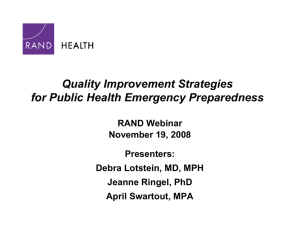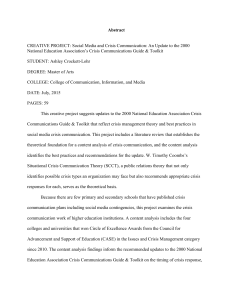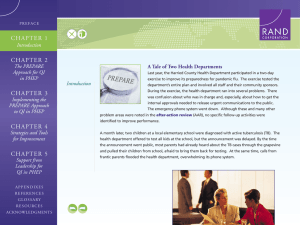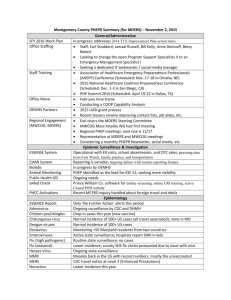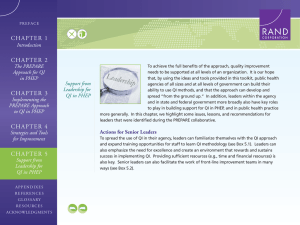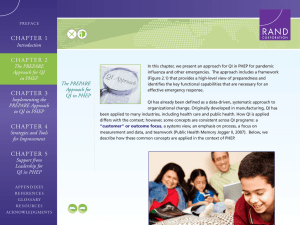C H A P T E R 1 Introduction
advertisement
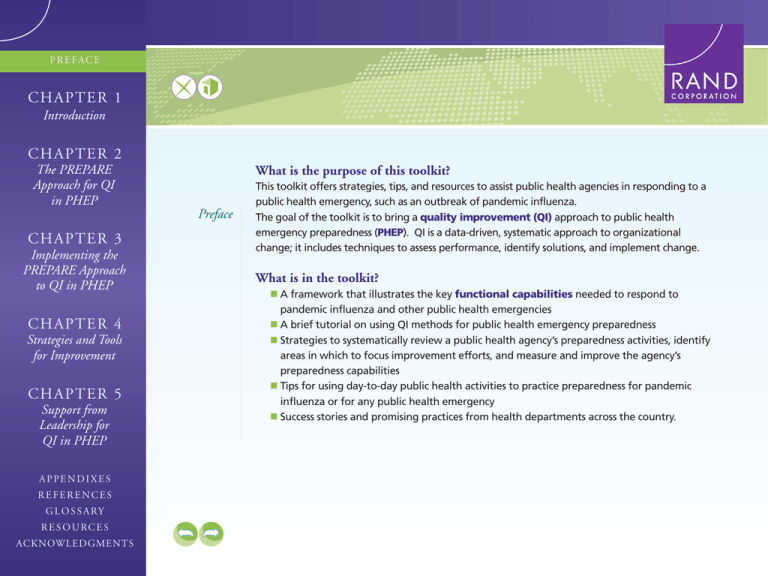
P R E FA C E CHAPTER 1 Introduction CHAPTER 2 The PREPARE Approach for QI in PHEP What is the purpose of this toolkit? Preface CHAPTER 3 Implementing the PREPARE Approach to QI in PHEP CHAPTER 4 Strategies and Tools for Improvement CHAPTER 5 Support from Leadership for QI in PHEP APPENDIXES REFERENCES G L O S S A RY R E S O U RC E S ACKNOWLEDGMENTS This toolkit offers strategies, tips, and resources to assist public health agencies in responding to a public health emergency, such as an outbreak of pandemic influenza. The goal of the toolkit is to bring a quality improvement (QI) approach to public health emergency preparedness (PHEP). QI is a data-driven, systematic approach to organizational change; it includes techniques to assess performance, identify solutions, and implement change. What is in the toolkit? A framework that illustrates the key functional capabilities needed to respond to pandemic influenza and other public health emergencies A brief tutorial on using QI methods for public health emergency preparedness Strategies to systematically review a public health agency’s preparedness activities, identify areas in which to focus improvement efforts, and measure and improve the agency’s preparedness capabilities Tips for using day-to-day public health activities to practice preparedness for pandemic influenza or for any public health emergency Success stories and promising practices from health departments across the country. P R E FA C E CHAPTER 1 Introduction CHAPTER 2 The PREPARE Approach for QI in PHEP How is this toolkit different from other resources out there? Preface CHAPTER 3 Implementing the PREPARE Approach to QI in PHEP It adapts QI tools such as process maps and performance measures for PHEP content Unlike other PHEP improvement approaches, the toolkit focuses on improving agency capabilities rather than assessing agency capacity for future action It focuses on ways to move from emergency response planning to implementation of new capabilities It emphasizes efforts that improve both day-to-day public health activities and preparedness. What are some of the benefits of using the toolkit? CHAPTER 4 Strategies and Tools for Improvement CHAPTER 5 Support from Leadership for QI in PHEP APPENDIXES REFERENCES G L O S S A RY R E S O U RC E S ACKNOWLEDGMENTS Using this toolkit can help public health agencies improve performance in preparedness activities while also strengthening partnerships within the agency and with external partners. With the approach in this toolkit, agencies can improve key day-to-day public health capabilities while improving emergency preparedness. P R E FA C E CHAPTER 1 Introduction CHAPTER 2 The PREPARE Approach for QI in PHEP How was this toolkit assembled? Preface CHAPTER 3 Implementing the PREPARE Approach to QI in PHEP These ideas were collected as part of a recent effort led by RAND researchers to identify exemplary practices in PHEP for pandemic influenza. The PREPARE for PI collaborative and toolkit are projects within the RAND program for Public Health Preparedness within RAND Health, a division of the RAND Corporation. Funding for these projects came from the Robert Wood Johnson Foundation and the U.S. Department of Health and Human Services (HHS), Office of the Assistant Secretary for Preparedness and Response (ASPR). How is the toolkit organized? The toolkit is divided into five chapters: CHAPTER 4 Strategies and Tools for Improvement CHAPTER 5 Support from Leadership for QI in PHEP APPENDIXES REFERENCES G L O S S A RY R E S O U RC E S ACKNOWLEDGMENTS CHAPTER ONE contains a brief overview of the value of QI in PHEP. CHAPTER TWO describes an approach for applying QI methods to improve the agency’s preparedness for pandemic influenza and other emergencies. CHAPTER THREE explains how to implement the QI approach. CHAPTER FOUR provides the core of the toolkit, with suggested aims, measures, tools, and improvement ideas related to preparedness. CHAPTER FIVE offers suggestions to assist senior agency leaders in supporting QI. Some of the tools identified in the toolkit are available in the “Appendixes” section. We provide a list of terms we define in this document in the “Glossary” section. Additional resources for PHEP and QI not directly referenced in the toolkit are listed in the “Resources” section. P R E FA C E CHAPTER 1 Introduction CHAPTER 2 The PREPARE Approach for QI in PHEP Preface CHAPTER 3 Implementing the PREPARE Approach to QI in PHEP CHAPTER 4 Strategies and Tools for Improvement CHAPTER 5 Who should use this toolkit? This toolkit is intended to help state and local health departments of all sizes incorporate QI methods and promising improvement strategies into their current emergency preparedness activities. The toolkit can be adapted to an agency’s needs and previous experience in using QI: Support from Leadership for QI in PHEP Those with little QI experience in general, or little experience applying QI to PHEP, might begin by reviewing Chapters One through Three, which provide a brief tutorial on the QI approach and how to implement it. APPENDIXES Those with previous experience in QI might turn directly to Chapter Four, which provides tools that can be used to implement QI in specific areas of preparedness. REFERENCES G L O S S A RY R E S O U RC E S ACKNOWLEDGMENTS P R E FA C E CHAPTER 1 Introduction CHAPTER 2 The PREPARE Approach for QI in PHEP Summary Preface CHAPTER 3 Implementing the PREPARE Approach to QI in PHEP CHAPTER 4 Strategies and Tools for Improvement CHAPTER 5 Support from Leadership for QI in PHEP APPENDIXES REFERENCES G L O S S A RY R E S O U RC E S ACKNOWLEDGMENTS Mounting an effective emergency response to a public health threat, such as an influenza pandemic, is a common challenge of state and local public health agencies across the country. A quality improvement (QI) approach is a data-driven, systematic approach to organizational change; it can provide a comprehensive way to assess current performance, identify shortfalls and solutions, and implement changes in public health emergency preparedness (PHEP). The PREPARE for Pandemic Influenza Quality Improvement Toolkit is intended to help state and local health departments of all sizes incorporate QI methods and promising improvement strategies into their current emergency preparedness activities. This toolkit was developed with the input of health departments from across the country, including those who participated in the 2006–2007 PREPARE for Pandemic Influenza (PI) Quality Improvement learning collaborative. P R E FA C E CHAPTER 1 Introduction CHAPTER 2 The PREPARE Approach for QI in PHEP Preface CHAPTER 3 Implementing the PREPARE Approach to QI in PHEP CHAPTER 4 Strategies and Tools for Improvement The toolkit provides a brief tutorial on using QI methods for public health emergency preparedness. The core of the toolkit provides suggested performance aims, measures, tools, and improvement ideas related to six key preparedness domains: surveillance case reporting and investigation command and control risk communication disease control disease treatment. Unlike other PHEP improvement approaches, the toolkit focuses on improving agency capabilities rather than assessing agency capacity for future action. Also emphasized are efforts that improve both day-to-day public health activities and preparedness. CHAPTER 5 Support from Leadership for QI in PHEP APPENDIXES REFERENCES G L O S S A RY R E S O U RC E S ACKNOWLEDGMENTS Greg Knobloch, CDC/ Taronna Maines, 2006
